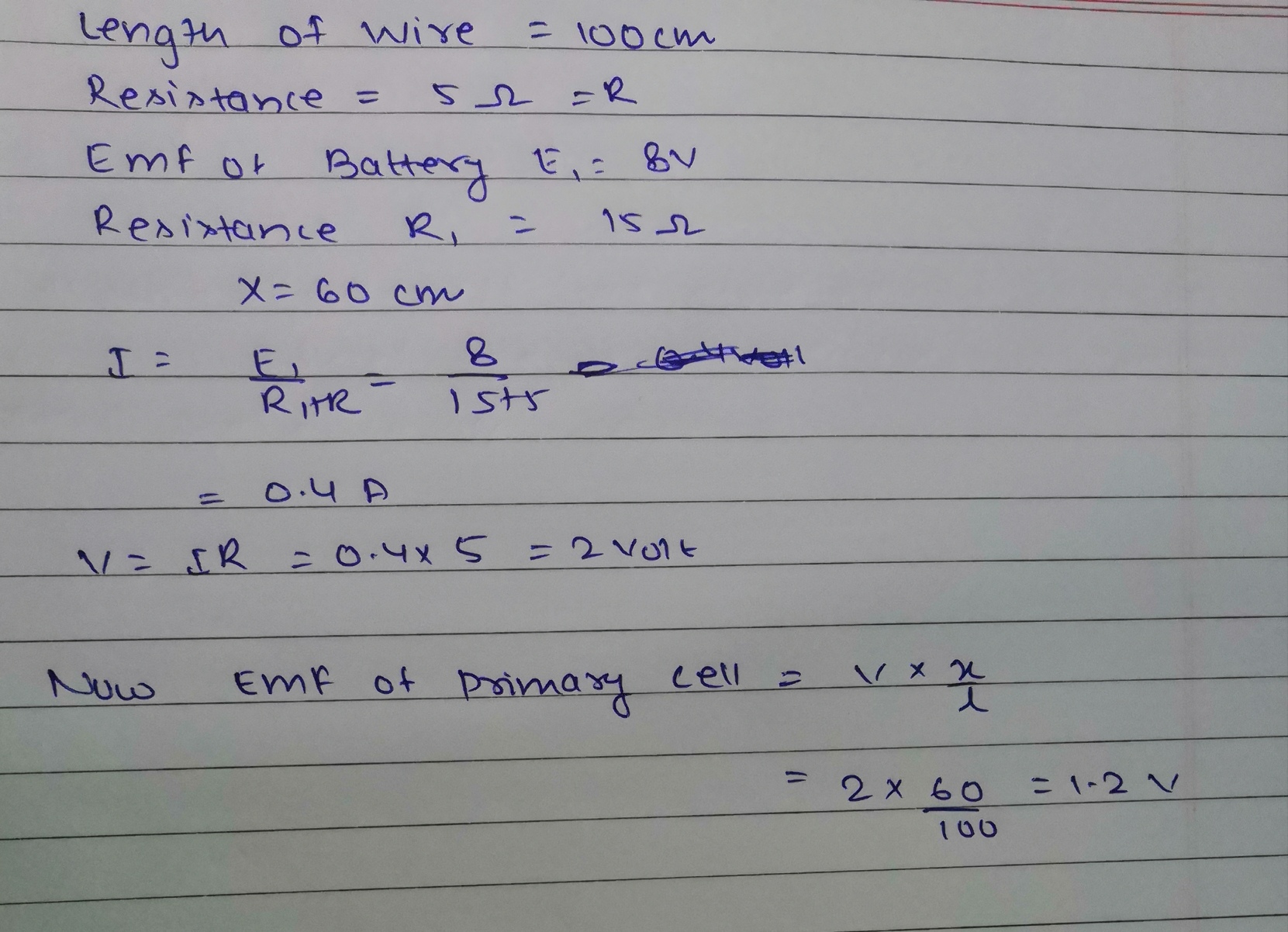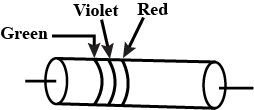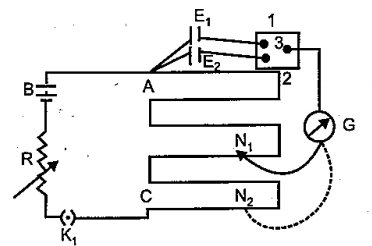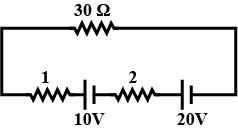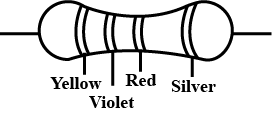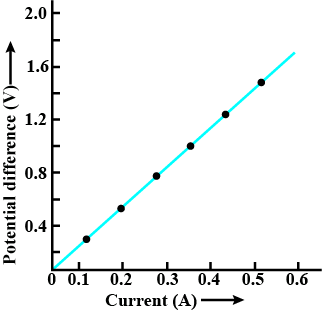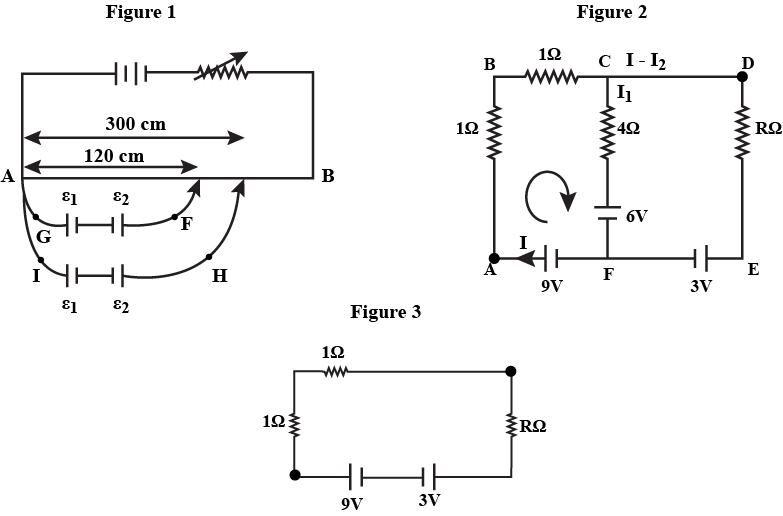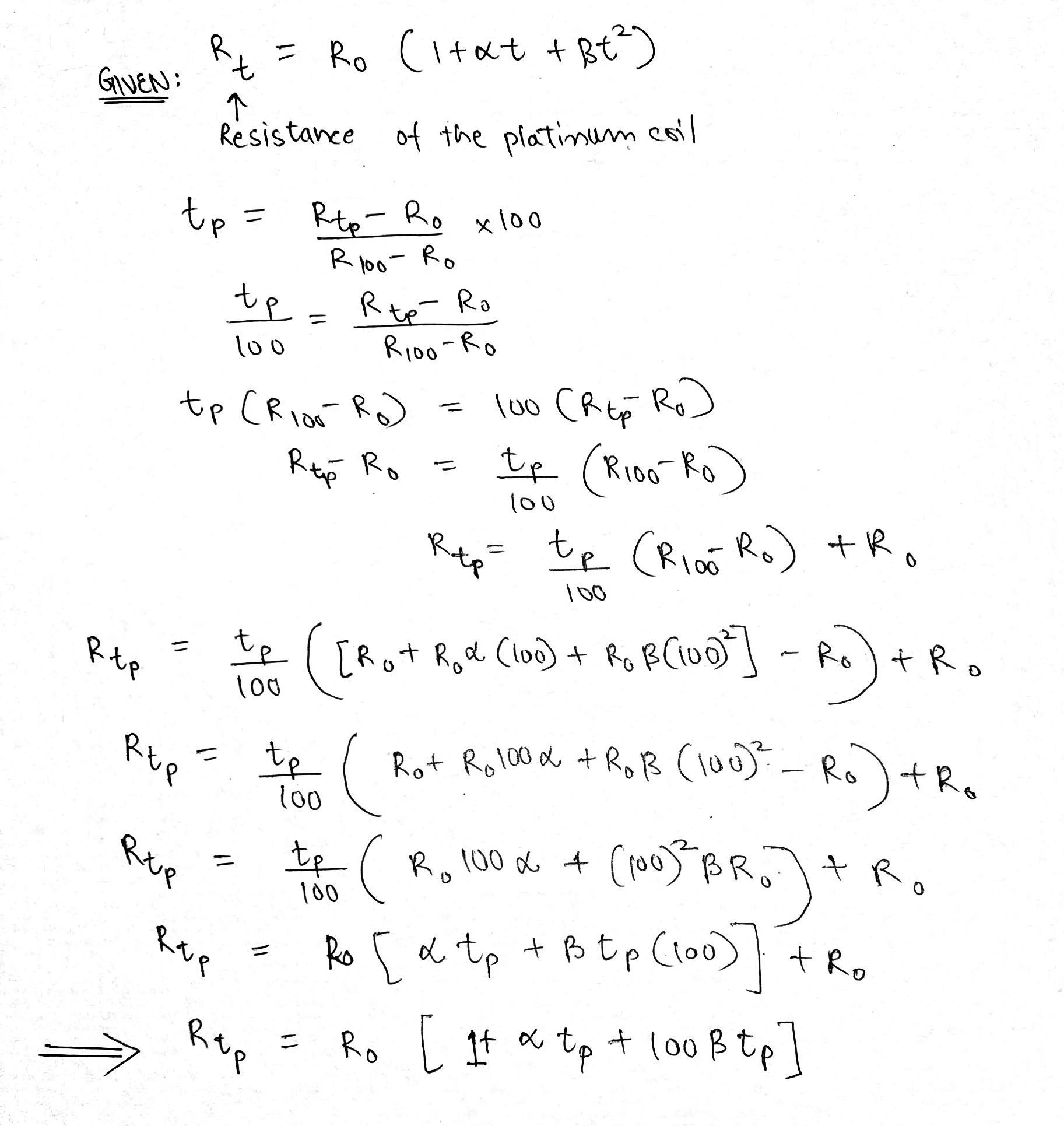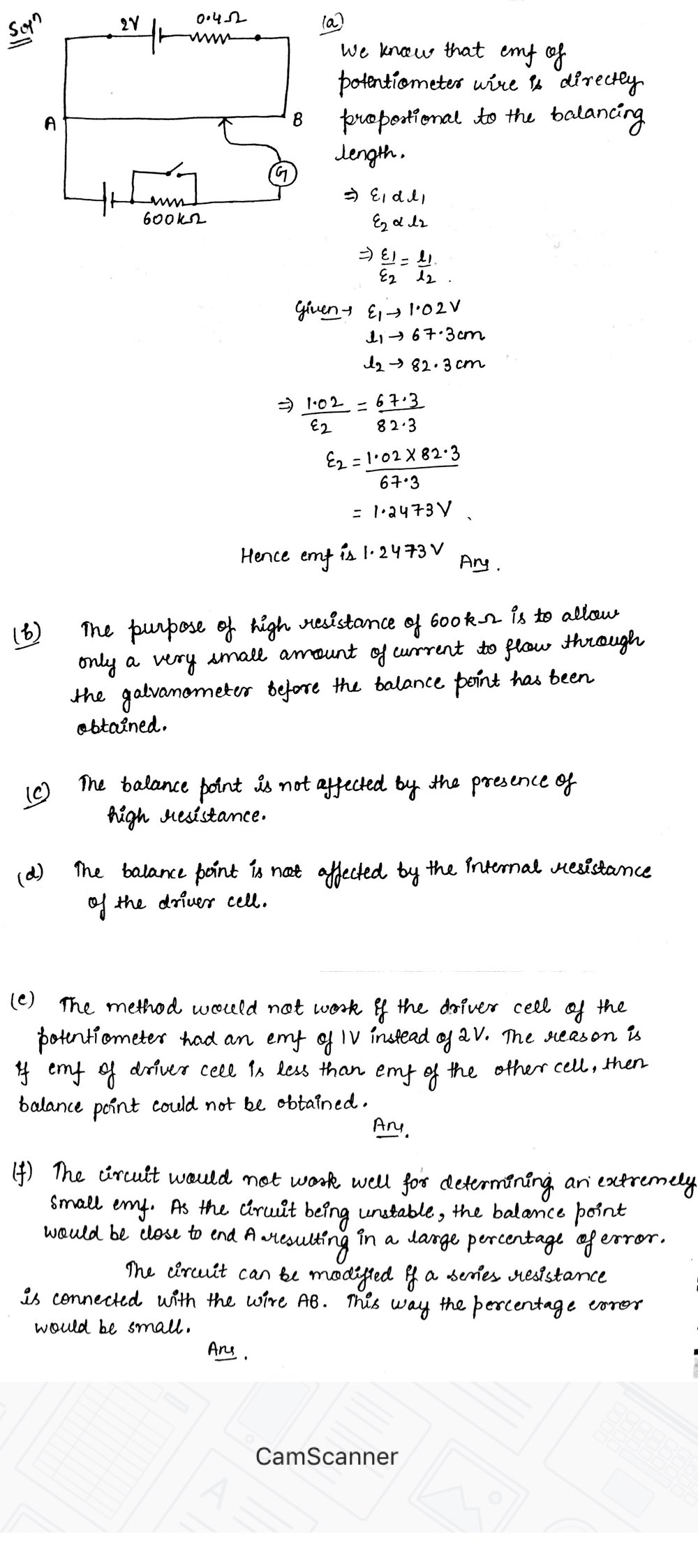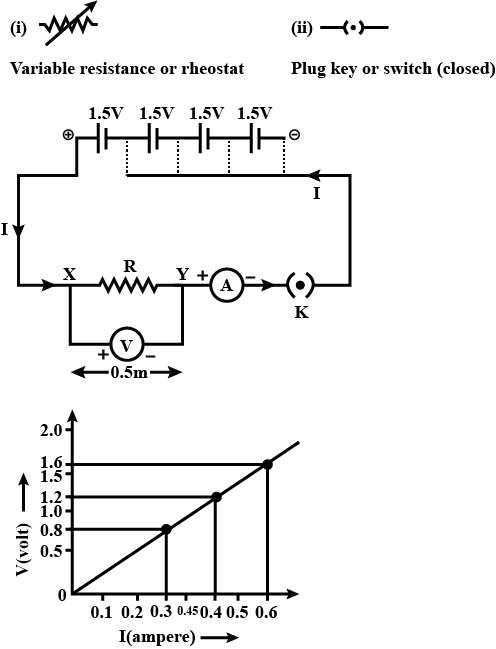Current Electricity - Class 12 Engineering Physics - Extra Questions
In the given circuit, a meter bridge is shown in a balanced state. The bridge wire has a resistance of 1 $$\Omega $$ / cm. Find the value of the unknown resistance X and the current drawn from the battery of negligible internal resistance.
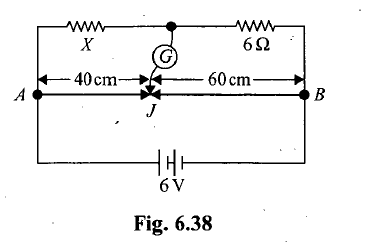
A resistance of R $$\Omega$$ draws current from a potentiometer as shown in the figure. The potentiometer has a total resistance $$R_0 \Omega$$. A voltage V is supplied to the potentiometer. Derive an expression for the voltage across R when the sliding contact is in the middle of the potentiometer.
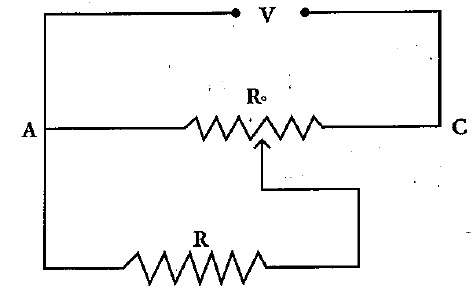
Calculate the area of cross section of a wire of length $$2$$ $$m$$, resistance $$46$$ $$\Omega$$ and resistivity $$1.84\times 10^{-6}$$ $$\Omega m$$.
According to kircholf`s second law:-
A potentiometer wire length $$1\ m$$, has a resistance of $$5\ \Omega$$. It is connected to a $$8\ V$$ battery, in series with a resistance of $$15\ \Omega$$. Determine the emf of the primary cell, which gives a balance point at $$60\ cm$$.
Does the value of resistance of a conductor depend upon the potential difference applied across it or current passes through it?
In the primary circuit of potentiometer the rheostat can be varied from $$0$$ to $$10\Omega$$. Initially it is at minimum resistance (zero). Find the length $$AP$$ (in m) of the wire such that the galvanometer shows zero deflection.

Match Column $$I$$ with Column $$II$$:
A 10 V battery of negligible internal resistance is connected across a 200 V battery and a resistance of $$38\omega $$ as shown in the figure. Find the value of the current in circuit.
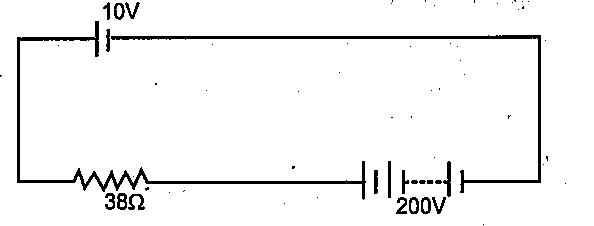
$$I - V$$ graph for a metallic wire at two different temperatures, $$T_{1}$$ and $$T_{2}$$ is a shown in the figure.
Which of the two temperature is lower and why?
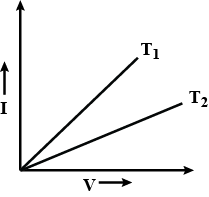
A carbon resistor is shown in the figure. Using colour code, write the value of the resistance.
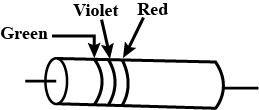
(a) State the working principle of a potentiometer. With the helps of the circuits diagram explain in how a potentiometer is used to compare the emf's two primary cells. Obtain the required expression used for comparing the emfs.
(b) Write two possible causes for one sided deflection in a potentiometer experiment.
A carbon resistor has a value of $$62 \times 10^3 \Omega$$ with a tolerance of 5%. Write colour code for this resistor in sequence.
How can e.m.f. of two cells be compared using potentiometer?
List the factors on which the resistance of a conductor in the shape of a wire depends.
The values of current(I) flowing through a given resistor of resistance (R), for the corresponding values of potential difference (V) across the resistor are as given.
| V(volts) | $$0.5$$ | $$1.0$$ | $$1.5$$ | $$2.0$$ | $$2.5$$ | $$3.0$$ | $$4.0$$ | $$5.0$$ |
| I(amperes) | $$0.1$$ | $$0.2$$ | $$0.3$$ | $$0.4$$ | $$0.5$$ | $$0.6$$ | $$0.8$$ | $$1.0$$ |
State Kirchhoffs law of electrical networks.
Fill in the blank.
In a straight conducting wire a constant current is flowing from left to right due to a source of emf When the source is switched off, the direction of the induced current in the wire will be .......... .
In the fig. the potentiometer wire $$AB$$ of length $$L$$ & resistance $$9\ r$$ is joined to the cell $$D$$ of e.m.f. $$\varepsilon $$ and internal resistance $$r$$. The cell $$Cs$$ e.m.f. is $$\varepsilon /2$$ and its internal resistance is $$2\ r$$. The galvanometer $$G$$ will show no deflection then find length $$AJ$$:
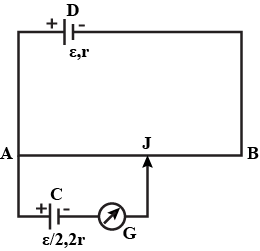
Answer the following questions using the above data:
Which of the wires has maximum resistance and why?
| Wire | Length | Diameter | Material | Resistance |
| $$A$$ | $$1$$ | $$2d$$ | Aluminium | $$R_{1}$$ |
| $$B$$ | $$2l$$ | $$d/2$$ | Constantan | $$R_{2}$$ |
| $$C$$ | $$3l$$ | $$d/2$$ | Constantan | $$R_{3}$$ |
| $$D$$ | $$1/2$$ | $$3d$$ | Copper | $$R_{4}$$ |
| $$E$$ | $$2l$$ | $$2d$$ | Aluminium | $$R_{5}$$ |
| $$F$$ | $$1/2$$ | $$4d$$ | Copper | $$R_{6}$$ |
Why conductivity of conductor decreases while of semiconductor increases with increasing temperature?
Ina potentiometer a standard cell of EMF 5V and of negligible resistance maintains a steady current through the potentiome :- r wire of length 5m Two primary cells of EMF $$E_1 and E_2$$ are joined in series with (i) same polarity and (ii) opposite polarity. The combination is connected through a galvanometer and a jockey to the potentiometer. The balancing lengths in the 2 cases are found to be 350 cm and 5 cm respectively.
A) Draw the necessary circuit diagram.
B) Find the value of the EMF's of the two cells.
Kirchoff's voltage law and current law are respectively in accordance with the conservation of (a) charge and momentum (b) charge and energy (c) energy and charge (d) energy and momentum
A metal wire of resistivity $$64\times 10^{-6}$$ $$\Omega$$ and length $$198$$ $$cm$$ has a resistance of $$7$$ $$\Omega$$. Calculate its radius.
A $$10Volts$$ battery of internal resistance one ohm is connected to a $$20Volt$$ battery of internal resistance $$2 ohm$$. The combination is put across a resistance of $$30 ohm$$. Find the current through each battery.
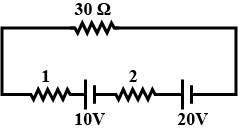
Write the colour code for $$4.7\ K\Omega \pm\ 10\%$$.
A cell of internal resistance 1.5 ohm and of e.m.f. 1.5 V balance on a potentiometer wire. If wire of 15 ohm is connected between the balance point and the cell,the balance point will shift:
Show that $$e=Bv1$$ where e is emf v is velocity of rods and 1 is length of rods
The plot of the variation of potential difference across a combination of three identical cells in series, versus current is shown alongside. What is the emf and internal resistance of each cell?
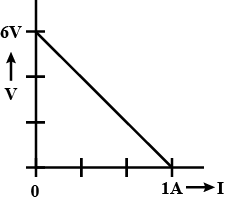
Plot a graph showing the variation of current $$I$$ versus resistance $$R$$, connected to a cell of emf $$E$$ and internal resistance $$r$$.
Two students $$X$$ and $$YY$$ perform an experiment on potentiometer separately using the circuit diagram shown here. Keeping the things unchanged
$$X$$ increases the value of resistance $$R$$
$$Y$$ decreases the value of resistance $$S$$ in the set up How would these charges affect the position of null point in each case and why?
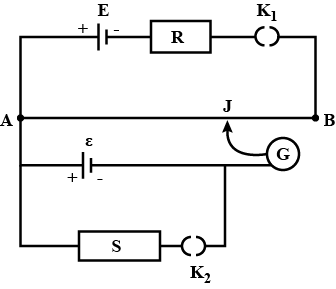
A metal wire of diameter $$4\ mm$$ and length $$100\ m$$ has a resistance of $$0.408\Omega$$ at $$10^{o}C$$ and $$0.508\Omega$$ at $$120^{o}C$$. Find the value of
its resistance at $$0^{o}C$$
Name the physical quantity whose unit is "ohm" .
A common flashlight bulb is rated at $$0.30$$ A and $$2.9$$ V
(the values of the current and voltage under operating conditions).
If the resistance of the tungsten bulb filament at room temperature
($$20^\circ C$$) is $$1.1 \Omega$$, what is the temperature of the filament when the
bulb is on?
(a) At what temperature would the resistance of a copper conductor be double its resistance at $$20.0 ^{\circ}C$$? (Use $$20.0^{\circ}C$$ as the reference point in Eq.; compare your answer with Fig. ) (b) Does this same “doubling temperature” hold for all copper conductors, regardless of shape or size?
Why is it generally preferred to obtain the balance point in the middle of the meter bridge wire?
The graph shown here shows the variation of terminal potential difference V, across a combination of three cells in series to a resistor,versus current i:
i) calculate the emf of each cell
ii) For what current I,will the power disslpation of he circuit be maximum?
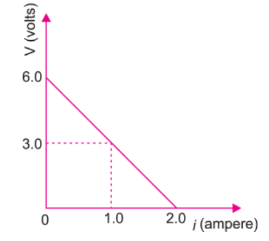
Two students 'X' and 'Y' perform an experiment on potentiometer separately using the circuit given.
Keeping other parameters unchanged,how ill the position of the null point be affected if
i) 'X' increasesnthe value of resistance R in the set-up by keeping the key K1 closed and the key K2 open?
ii) 'Y ' decreases the value of resistance S in the set-up,while the key K2 remain open and the key K1 closed? Justify your answer in each case.
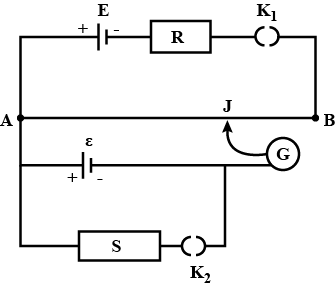
Two primary cells of emfs wire $$\varepsilon_1$$ and $$\varepsilon_2$$ $$(\varepsilon_1 > \varepsilon_2)$$ are connected to a potentiometer wire AB a shown in fig.If the balancing lengths for the two combinations of the cells are 250 cm and 400 cm, find the ratio of $$\varepsilon_1$$ and $$\varepsilon_2$$
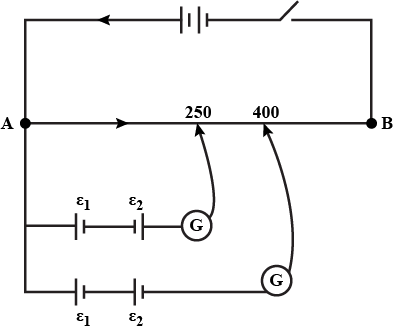
Two cells of emf 1 V, 2 V and internal resistances $$2\Omega$$ and $$1\Omega$$ respectively are connected in (i) series (ii) Parallel.What should be the external resistance in the circuit so that the current through the resistance be the same in the two cases? In which case is more heat generated in the cells?
A potentioeter wire of length 1m is connected to a driver cell of emf 3 V as shown in the figure.When a cell of 1.5 V emf is used in the secondary circuit,the balance point is found to be 60 cm. On replacing this cell and using a cell of unknown emf,the balance point shifts to 80 cm.
In the potentiometer circuit shown,the null point is at X.State with reason, where the balance point will be shifted when:
a) Resistance R is increased,keeping all other parameters unchanged;
b) Resistance S is increased,keeping R constant.
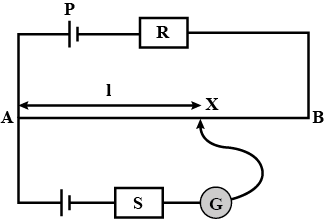
Calculate the temperature at which the resistance of a conductor becomes 20 % more than its resistance at $$27^oC$$. The values of the temperature coefficient of resistance of the conductor is $$2.0 \times 10^{-4}/K$$
Draw a graph to show current voltage relationship of an ohmic resistor.
Write an expression connecting the resistance and resistivity. State the meaning of symbols used.
In the figure, calculate the total resistance of the circuit
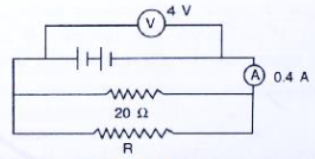
Te following table shows current in Amperes and potential difference in Volts. Find the average resistance.
| V (Volts) | I (Amp) |
| 4 | 9 |
| 5 | 11.25 |
| 6 | 13.5 |
Make a diagram of experimental verification of Ohm's.
In the figure a long uniform potentiometer wire AB is having a constant potential gradient along its length. The null points for the two primary cells of emfs $$\varepsilon _{1}$$ and $$\varepsilon_{2}$$ connected in the manner shown are obtained at a distance of 120 cm and 300 cm from the end Find(i)$$\varepsilon_{1} / \varepsilon_{2}$$ and (ii) position of null point for the cell $$\varepsilon_{1}$$. How is the sensitivity of a potentiometer increased?
OR
Using kirchoff's rules determine the value of unknown resistance R is the circuit so that no current flows through $$4\;\Omega$$ resistance. Also find the potential difference between A and D.
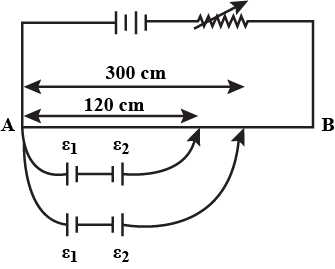
Write the principle on which the working of a metre bridge is based. In an experiment on meter bridge, student obtains the balance point at the point $$J$$ such that $$AJ=40cm$$, as shown in figure. The values of $$R$$ and $$X$$ are both doubled and then interchanged. Find the new position of the balance point. If the galvanometer and battery are also interchanged how will the position of balance point be affected
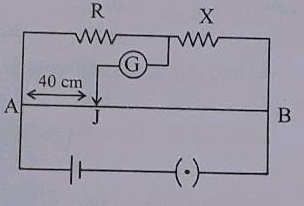
For the given potentiometer circuits , potential gradient is $$0.025V/m$$ and the ammeter reading is $$0.1$$ A. Now, when terminals $$1$$ and $$2$$ are connected balance point is obtained at $$40cm$$. Also when terminals $$1$$ and $$3$$ are connected balance point in obtained at $$100cm$$. If $$3R=kX$$, then the value of k will be

A platinum resistance thermometer is constructed which reads $$0 ^ { \circ }$$ at ice point and $$100 ^ { \circ }$$ at steam point. Let $$t _ { p }$$ denote the temperature on this scale and let $$t$$ denote the temperature on a mercury thermometer scale. The resistance of the platinum coil varies with $$t$$ as $$R _ { t } = R _ { 0 } \left( 1 + \alpha t + \beta t ^ { 2 } \right) .$$ Derive an expression for the resistance as a function of $$t _ { p }.$$
Figure 6.36 shows a potentiometer with a cell of e.m.f. 2.0 V and internal resistance 0.4 $$\Omega $$ maintaining a potential drop across the resistance wire AB. A standard cell which maintains a constant e.m.f. of 1.02 V (for very moderate currents upto a few uA) gives a balance point at 67.3 cm length of the wire. To ensure very low current is drawn from the standard cell, a very high resistance of 600 k $$\Omega $$ is put in series with it which is shorted close to the balance point. The standard cell is the replaced by a cell is then replaced by a cell of unknown e.m. f.$$\varepsilon $$ and the balance point found,similarly, turns out to be at 82.3 cm length of the wire.
1) What is the value of $$\varepsilon $$
2)What purpose of the high resistance of 600 k $$\Omega $$
3)Is the balance point affected by this high resistance
4)Is the balance point affected by internal resistance of the driver cell
5)Would the method work in the above situation if the driver cell of the potentiometer had an e.m.f. of 1.0 V instead of 2.0 V
6)Would the circuit work well for determining an extremely small e.m.f., say of the order of a few mV (such as the typical e.m.f. of a thermocouple ) If not, how will you modify the circuit
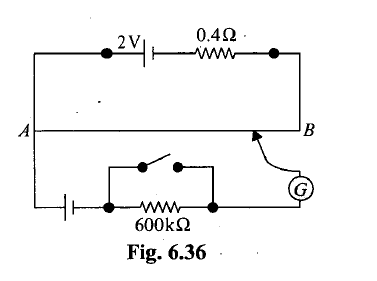
In the meter bridge experiment,balance point was observed at J with AJ=I.
i) The values of R and X were doubled and then interchanged.What would be the new position of balance point?
ii) If the galvanomater and battery are interchanged at the balance position,how will the balance point get-affected?
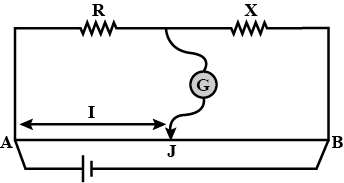
a) State Kirchhoff's rules and explain on what basis they are justified.
b) Two cells of emfs $$E_1$$ and $$E_2$$ and internal resistance $$r_1$$ and $$r_2$$ are connected in parallel.Derive the expression for the (i) emf and (ii) internal resistance of a single equivalent cell which can replace this combination.
(a) Name an instrument that measures electric current in a circuit. Define the unit of electric current.
(b) What do the following symbols represent in a circuit diagram?
(c) An electric circuit consisting of a $$0.5\ m$$ long nichrome wire $$XY$$, an ammeter, a voltmeter, four cells of $$1.5\ V$$ each and a plug key was set up.
(i) Draw the electric circuit diagram to study the relation between the potential difference maintained between the points $$'X'$$, and $$'Y'$$, and the electric current flowing through $$XY$$.
(ii) Following graph was plotted between $$V$$ and $$I$$ values using above circuit:
What would be the values of $$\vec {V}{1}$$ ratios when the potential difference is $$0.8\ V, 1.2\ V$$ and $$1.6\ V$$ respectively? What conclusion do you draw from these values?
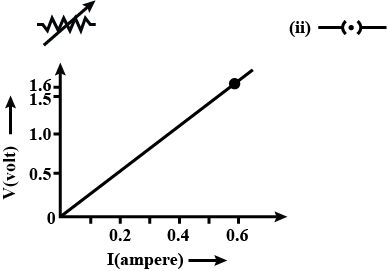
(a) What is the ratio of potential difference and current known as ?
(b) The values of potential difference $$V$$ applied across a resistor and the corresponding values of current $$I$$
following in the resistor are given below :$$Potential\ difference, V(in\ volts)$$ : $$2.5\ \ \ \ \ 5.0\ \ \ \ \ 10.0\ \ \ \ \ 15.0\ \ \ \ \ 20.0\ \ \ \ \ 25.0$$$$Current,\ I(in\ amperes)$$ : $$0.1\ \ \ \ \ 0.2\ \ \ \ \ 0.4\ \ \ \ \ \ \ 0.6\ \ \ \ \ \ \ 0.8\ \ \ \ \ \ 1.0$$
Plot a graph between V and I, and calculate the resistance of the resistor.
(c) Name the law which is illustarted by the above $$V - I$$ graph.
(d) Write down the formula which states the relation between potential difference , current and resistance.
(e) The potential difference between the terminals of an electric iron is $$240 \,V$$ and the current is $$5.0 \,A.$$ What is the resistance of the electric iron ?
(b) The values of potential difference $$V$$ applied across a resistor and the corresponding values of current $$I$$
following in the resistor are given below :
Plot a graph between V and I, and calculate the resistance of the resistor.
(c) Name the law which is illustarted by the above $$V - I$$ graph.
(d) Write down the formula which states the relation between potential difference , current and resistance.
(e) The potential difference between the terminals of an electric iron is $$240 \,V$$ and the current is $$5.0 \,A.$$ What is the resistance of the electric iron ?
In an experiment to study the relation between the potential difference across a resistor and the current through it, a student recorded the following observations:On examining the observations the teacher asked the student to reject one set of reading as the values were out of agreement with the rest. Which one of the below sets of readings can be rejected? Calculate the mean value of resistance of the resistor based on the remaining four sets of reading.
Potential difference $$V$$ (volts)
$$1.0$$
$$2.2$$
$$3.0$$
$$4.0$$
$$6.4$$
Current $$I$$ (amperes)
$$0.1$$
$$0.2$$
$$0.6$$
$$0.4$$
$$0.6$$
| Potential difference $$V$$ (volts) | $$1.0$$ | $$2.2$$ | $$3.0$$ | $$4.0$$ | $$6.4$$ |
| Current $$I$$ (amperes) | $$0.1$$ | $$0.2$$ | $$0.6$$ | $$0.4$$ | $$0.6$$ |
Class 12 Engineering Physics Extra Questions
- Alternating Current Extra Questions
- Atoms Extra Questions
- Current Electricity Extra Questions
- Dual Nature Of Radiation And Matter Extra Questions
- Electric Charges And Fields Extra Questions
- Electromagnetic Induction Extra Questions
- Electromagnetic Waves Extra Questions
- Electrostatic Potential And Capacitance Extra Questions
- Magnetism And Matter Extra Questions
- Moving Charges And Magnetism Extra Questions
- Nuclei Extra Questions
- Ray Optics And Optical Instruments Extra Questions
- Semiconductor Electronics: Materials,Devices And Simple Circuits Extra Questions
- Wave Optics Extra Questions
